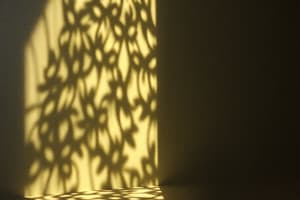Podcast
Questions and Answers
Which factor does NOT influence the size and shape of a shadow?
Which factor does NOT influence the size and shape of a shadow?
- The orientation of the object casting the shadow
- The color of the object casting the shadow (correct)
- The source and direction of the light
- The distance between the light source and the obstacle
What happens when light waves are refracted?
What happens when light waves are refracted?
- They create a fuzzy boundary around objects
- They change direction as they pass from one medium to another (correct)
- They are absorbed completely by the medium
- They bounce off a surface at an equal angle
Which field benefits from the understanding of light and shadow?
Which field benefits from the understanding of light and shadow?
- Chemistry
- Zoology
- Optics (correct)
- Botany
Flashcards are hidden until you start studying
Study Notes
Light and Shadow in Physics
Light and shadows are integral parts of our visual perception, yet their understanding goes far deeper than simply seeing. Let's delve into the scientific side of these phenomena as they relate to the discipline of physics.
Understanding Light
At its core, light is electromagnetic radiation that travels in waves. These waves carry energy and can interact with matter in various ways, leading to reflection, refraction, absorption, emission, and scattering—all key aspects of optical phenomena. Each component color in visible light corresponds to a range of wavelengths known as spectral bands. Incident sunlight comprises approximately 5% visible light, while the remaining near-visible spectrum lies outside the visible frequency range.
Exploring Shadows
Shadows occur when an object blocks incoming light from illuminating a region behind it. The size and shape of a shadow depend on multiple factors, including the source and direction of the light, the distance between the light source and the obstacle, and the orientation of the object casting the shadow. Different types of objects cast distinct shadows; opaque ones create sharp edges where they meet the background surface, while translucent structures produce fuzzy boundaries due to partial transmission of light.
Applications in Optics and Beyond
Understanding light and shadow plays a crucial role in several fields of optics, including astronomy, imagery, and display technologies. By controlling and manipulating light, scientists can create innovative devices such as cameras, microscopes, telescopes, lasers, and projectors. Additionally, exploring the behavior of light and shadow contributes to a broader understanding of physical processes related to planetary motion, stellar evolution, and the nature of dark matter.
In conclusion, the relationship between light and shadow is complex and multilayered, involving not only our everyday observations but also advanced theories in modern physics and various technological advancements. As researchers continue to uncover new insights into these fundamental aspects of reality, our knowledge expands, leading to further innovations and discoveries.
Studying That Suits You
Use AI to generate personalized quizzes and flashcards to suit your learning preferences.




